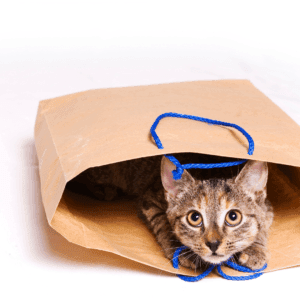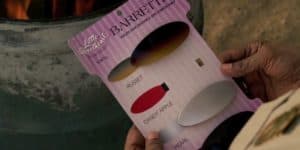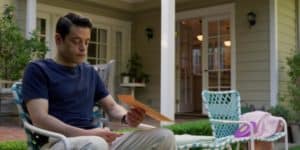The Little Things: How to Write a Trick Ending
This week, we’re going to be talking about The Little Things by John Lee Hancock, as well as some other films with the greatest trick endings of all time, like The Sixth Sense, The Usual Suspects and Se7en. Specifically, we’re going to be answering the question: how do you write a trick ending in your screenplay?
If you haven’t seen The Little Things yet, don’t worry, I am going to talk about the plot, but I will not give away the big surprise until the very end. And I promise I’ll warn you before we get there.
And if you have seen the movie, then you and I probably can agree that it has (what should be) a really fun trick ending, the kind of trick ending that we all look for, that wonderful moment that seems connected to character, that has emotional stakes to it, that surprises the audience, that’s even is a riff on the title of the script.
It’s a nice little moment, or at least it should be.
But somehow, you probably found that the trick ending in The Little Things left you just a little bit cold. It just doesn’t totally land. In your head, (if you didn’t see it coming), you might still think, “oh, that’s interesting, that’s a cool trick ending.” But in your heart, you don’t really feel the trick ending.
That happens for a very simple reason.
So in looking at The Little Things we’re going to talk about exactly why the trick ending doesn’t work to its full potential, and how to write a trick ending for your screenplay that works both intellectually and emotionally.
Often, when your trick ending isn’t landing, or for that matter, when any element of your script isn’t landing, you rush back to rewrite, and you start to get focused on all the little details that aren’t working.
And, of course, we could talk about all the little details of The Little Things. We could talk about the kind of clunky exposition at the beginning where we’re told again, and again, and again, and again about Denzel’s nervous breakdown and what a messed up cop he was before he lost his job and ended up at this crappy little out-of-town precinct.
We could talk about the good things about this script. We could talk about the wonderful performance of Jared Leto’s character, and the nice little twist on the serial killer that we see with him. We could talk about the cool 90’s throwback stuff and the old technology of solving a crime. We could talk about the pacing of the script.
These are exactly the kinds of things that we often get obsessed with when we rewrite, especially when something big isn’t working in our script. All those little details. “Oh, no, I messed up this little line of dialogue…”
But what I want to tell you is that these are the little things. They’re not the big ones.
And as screenwriters, as much as we care about the details, we actually have to make sure we take care of the big things before we take care of the little ones. (Even if we’re writing a script called The Little Things).
 The reason the trick ending of The Little Things isn’t landing has absolutely nothing to do with all the little clunky execution issues in the script.
The reason the trick ending of The Little Things isn’t landing has absolutely nothing to do with all the little clunky execution issues in the script.
The truth is, the script could survive those clunky issues, even though I wish the writer had cleaned them up. The real reason the ending doesn’t land comes down to what almost always gets in the way of trick endings: it’s all about the characters.
The first key in writing a trick ending that works is making sure that the trick ending isn’t just happening for the audience. It’s also happening for the characters.
And that’s especially important if you’re writing a two-hander like The Little Things.
By two-hander I mean, there are really two characters in The Little Things. Sure, you have Jared Leto’s character, Albert Sparma, the serial killer, and he gives a fabulous performance and he’s a really fascinating dude. But the hunt for the serial killer in The Little Things is really not very interesting. There’s really only one potential guy who could have done it, and we’ve seen this kind of police procedural tracking stuff in everything from Law and Order to Dexter. So there’s nothing new here.
That means the drama can’t be about catching the serial killer. The drama has to be about the relationship between Deke and Jim, between Denzel Washington and Rami Malek. It’s got to be about those two characters.
We need the journey to take place between those two characters so that that end can actually land– not for us, for them. We need to feel that huge switch, that huge twist, that huge flip of the emotional and thematic stakes, not in our head, but in our hearts. We need to feel how that moment changed everything for those two characters.
If you want a great example of a movie with a trick ending that totally flipped the emotional and thematic stakes, listen to my podcast on The Sixth Sense.
A lot of people think that in order to write a powerful trick ending like that of The Sixth Sense, you probably need to know where you’re going from the start. But that’s not always true.
It is true that in order to land the trick ending, you need to look at the beginning of your script, and you need to make sure that when you take the beginning and you take the end, that those two pieces are speaking to each other. But often we end up writing without really knowing the ending that we’re building for, whether it’s a trick ending or anything else.
In fact, one of the most common realizations writers have is that the end we think we’re building for is not actually the end– it’s the middle! It’s a natural part of the phenomenon of writing that as we write the script, we find that it goes to a much deeper and more complicated place than we ever could have imagined when we first sat down to write it.
So that means that once you find that great trick ending, or that great ending of any kind, you often need to work backwards– not engineering toward the trick ending, but engineering backwards from it!

You have to look at where you started, you need to look at every element that brought you there, and you need to make sure that you’re not just building the plot that leads to the trick ending, but that you’re also building the structure. The first of these, building the plot, The Little Things does quite clearly. But when it comes to the more important one, building the structure, it struggles.
A lot of writers get really hung up on plot and structure. They use those two words interchangeably, but they’re so very different!
Plot is just the stuff that happens in your script. It’s the stuff that happens to happen to your character.
But the structure is the choices the character makes in relation to that stuff. It’s the choices they make in relation to the plot and the way those choices change them forever.
And in a movie like The Little Things, it’s the choices that Denzel Washington and Rami Malek, that Deke and Jim, make in relation to each other that need to build up to the emotional stakes of the trick ending.
So getting back to The Sixth Sense, M. Night Shyamalan had no idea when he started writing that script that Bruce Willis’s character was dead. He had no idea what the trick ending was.
It wasn’t until many drafts into writing that script that he realized, “Oh, my God, this guy’s dead.” And that’s his quote, that’s not my words. “Oh, my God, this guy’s dead!” And just listen to that. That’s not “Oh, my God, I could make this guy dead.” That’s “Oh, my God, this guy’s dead. And I didn’t even realize it.”
What’s so cool about the trick ending of The Sixth Sense is that M. Night Shyamalan realizes it and the audience realizes it at the same moment that Bruce Willis’s character realizes it!
What he did from that point of discovery was embark on rewriting– many more drafts, where he worked back from that trick ending and created the structural journey for the character that was going to let it land emotionally.
What that looks like in the final draft is so powerful because you have this kind psychologist who just wants to help this boy, and around him, his relationship is devolving and he doesn’t know why. He can’t seem to connect to his wife. He’s losing his focus, but he knows that he has to help this boy.
 And it’s not till the very end of the movie, that he realizes it’s actually the other way around. That even though he is helping this boy, this boy is also helping him. That he is the one with the bigger problem. He’s the ghost who doesn’t know he’s dead.
And it’s not till the very end of the movie, that he realizes it’s actually the other way around. That even though he is helping this boy, this boy is also helping him. That he is the one with the bigger problem. He’s the ghost who doesn’t know he’s dead.
And you can see that that moment isn’t just a surprise for the audience, it’s a complete flip for the main character. It’s a complete reversal of the emotional and thematic stakes. It’s a complete change from who he thought he was, to realizing who he really is. It’s the completion of the character’s journey and his change in the script.
For an even more complicated trick ending that works, we could look at a script like The Usual Suspects.
If you watch The Usual Suspects, what you’ll realize is what makes that trick ending land is not learning that Verbal was lying and happened to be Keyser Söze all along. That’s just an intellectual trick. And in fact, that intellectual trick doesn’t even really lead us anywhere. You can’t actually look back at The Usual Suspects and go, “oh, now I understand what really happened.” No, actually, all you know is that Verbal made some stuff up.
The stakes don’t come from the trick ending of us realizing Verbal is Keyser Söze. That’s just the intellectual part.
The emotional stakes come from watching Verbal’s journey.
What we’re watching, over the course of The Usual Suspects, is this man who believes he knows who he is, who gets broken down, humbled, devastated. We watch him be forced to recognize that his one friend in the world, the friend that he trusted, the friend he’s been trying to protect, in fact, betrayed him. That there is no one looking out for him, that he’s been exploited, in the words of the cop who’s interrogating him, because he’s weak, because he’s a cripple. He’s been exploited by his friends. He’s been exploited by the men he most admires in the world. And he’s been exploited by this detective. He’s the one who has no power, and they have all the power in the world.
And because we watch him get broken down, and experience it as real, even though he’s just pretending, we still go on that emotional journey with him.
So that at the very end, when we flip it, and we realized that he had the cards in his hand all along, that he actually was the one with the power, that he actually was Keyser Söze, it’s a complete flip in the power dynamic of how we experienced the character.
It’s that flip, it’s mourning with him, and then watching him flip back up to the top of the world, that gives us the emotional experience of that ending. That’s what makes that ending actually matter.
Your ending (just like everything else in your movie) only matters in relation to the main character ‘s journey.
Most trick endings go awry for a different reason than the trick ending of The Little Things goes awry.
Most trick endings go awry because the writer, having figured out this incredible trick ending that no one’s ever thought of before, ends up hiding all the details that would allow you to actually get invested in the character. “Oh, this can’t happen, because it would give away the trick ending. Oh, they can’t make this choice, because it would give away the trick ending. Oh, they can’t do this, because it would give away the trick ending.”
In fact, you can see a piece of this in Denzel Washington’s character in The Little Things. Without giving too much away, we know that something happened to Deke that caused him to have some kind of really dark nervous breakdown, that caused him to lose the respect of everyone else on the force, that caused him to basically hide himself away in some crappy desk job at some crappy police precinct.
We know that something happened. And the writer doesn’t want to let us know what happened until the very end. And it’s handled at the very end with a flashback. And oddly, you don’t feel a lot when you experience it, even though there are a couple of clues along the way that finally makes sense.
This is the classic problem. If they had just allowed Denzel to wrestle with what happened to him, to share what happened to him with Jim, to confront his old boss about what happened to him, to actually come to grips with what happened to him over the course of the movie, it might not have had that element of surprise, but it would probably be a more interesting movie! Because we’d actually get to feel him go on a journey in relation to that secret.
Instead, because we don’t even know what he was reacting to, we don’t even know what changed him. When we finally find out, it barely matters to us, because we weren’t on that emotional ride with him.
Similarly, it forces so much to happen in exposition from other characters, because we just can’t allow him just to talk, just to be real. It also gets in the way of building his relationship with Rami Malek’s character, with Jim, because he can’t talk about his experience. And in fact, it’s that experience that is ultimately going to link him to Jim. That’s actually going to allow these two very different men to understand each other.
That is the standard reason why trick endings get in the way of drama, and why it can be so hard for writers to write a trick ending that works in a screenplay without losing the emotional and thematic stakes that make it matter.
I learned this the hard way. I was writing a script called Love/Murieta. The story is based on the legend of Joaquin Murieta, who’s actually the inspiration for Zorro, and it’s an awesome story. A producer had come to me with the idea of doing an adaptation of the story, and no one was asking me to write a trick ending. But along the way, I came up with the coolest trick ending ever. And boy, did it mess up my script!
It messed up my script because, at that point in my career, even though I was working professionally, I actually didn’t yet have the craft to land that trick ending without losing the drama between the characters.
And what ended up happening was, I had to hide so many incredible elements of the legend in order to get to my trick ending. I had to avoid showing so many elements to my audience, that by the time we got to the trick ending, at least in my early draft, it was hard to actually care, because you hadn’t connected to the character in the first place. It took many, many drafts to finally get it to work. But the biggest impediment was not the story, it was my fear of “ruining” the trick ending, by giving too much away too soon.
So if that’s your problem, then you don’t even need to listen to the rest of the podcast. If that’s your problem, you can do something very simple, which is just ask yourself, “What would happen if I  stopped hiding anything from my audience? What would happen if I let the cat out of the bag?”
stopped hiding anything from my audience? What would happen if I let the cat out of the bag?”
That’s now my rule for myself. At the moment that I realize a trick ending is getting in the way of the drama, I let the trick ending out of the bag, I just let the story happen. I get it down truthfully, and one of two things will generally happen along the way:
Either an even better trick ending will come to me, which means my script just got even better, or I’ll learn what the real bones of the script are, what the real relationships are. And then it becomes easier to work back into a rewrite, like a surgeon with a scalpel, asking “okay, how am I going to hide this piece?”, or “how am I not going to show this yet?”, or “what’s another way around this so that my trick ending can actually land?”
If your trick ending is tying your hands behind your back as a writer, free your hands! And know you’ll have plenty of time, just like M. Night Shyamalan, to work back into your script to find a way to make that trick ending land, once you know the real route by which you got there.
Interestingly, The Little Things actually goes astray for a different reason than most scripts with trick endings.
It’s actually not the flashback about Deke that destroys the trick ending, because the writer actually has a much more interesting trick ending up his sleeve than that little flashback.
So the truth is, even though again, this is not the best writing, the script could have survived the not so important flashback, it could have even survived the negative effects of not allowing Denzel to actually process his journey because we’re trying to hide it from the audience.
The main reason the trick ending doesn’t land in The Little Things is actually because the writer loses track of his own brilliant premise!
The writer loses track of his own incredible characters, the writer loses track of the thing that makes the characters so darn interesting.
And when he loses track of that, what ends up happening is the engine for the trick ending, the structure that was going to make the trick ending work, ends up falling apart.
And this is really sad. And we see it, actually, all the time.
Because here’s the thing, The Little Things is not a bad script. The Little Things is actually a good script that got shot a couple drafts too early, that simply needed more revision. 
And the odd thing is, the revision didn’t require John Lee Hancock to come up with a single thing that wasn’t already in the movie. It actually just required him looking back more specifically at what he set up and asking himself how he could keep doubling down on the great idea he already had, rather than losing track of it as he finds his way into the middle of the story.
So let’s talk about what that thing is. The big thing that’s already in the script, that with a few rewrites could have allowed the trick ending of The Little Things truly land with it’s full force and power.
Here’s the setup. You’ve got two cops. The first is Deke, played by Denzel Washington. And Deke, well, let’s be honest, he’s a character we’ve seen before. He is the old grizzled cop, who has seen too much, who has escaped the big city precinct for a little job where nothing bad happens. And now he’s got to go back to the big city.
And while it’s true that the old grizzled cop is one of those tropes we’ve seen a million times, there is an interesting element to this version character. Now, we don’t actually get to see that element in the execution of the script. But we’re told about it, in lots and lots of crappy exposition. And despite the fact that the elements we’re learning about are not fully executed, the writer has a really good idea.
His idea is that Deke might not be a good cop.
In fact, no one seems to like Deke very much at all. This is not the Morgan Freeman character from Se7en, the cop who has stared at the face of evil and doesn’t want to see evil anymore and is running from it.
This is a cop who didn’t just have a nervous breakdown, but did something that no one’s talking about, but that no one respects him for. This is not a good cop who’s seen too much. This is a bad cop who’s seen too much. It’s a fun little twist on the genre.
And when he comes back to his old precinct, there’s Rami Malek, Jim. And Jim is the young hot shot cop who has taken Deke’s role on the force. And this is also a character we’ve seen a million times before too. The young hotshot who thinks he knows everything, teamed up with the grizzled old cop who’s seen too much. In fact, this is the Brad Pitt character from Se7en.
But again, John Lee Hancock has a nice little twist on the genre. The way people are talking about Rami Malek, it seems like he is actually a really good cop. It seems like Jim actually is everything that Deke failed to be, the cop who knows more than Deke, who’s better at his job than Deke, who’s smarter than Deke. Not the young cop who thinks he knows everything, the young cop who actually knows how to handle himself, who actually has a moral compass, who actually can somehow manage the pressures of the job and his lovely, perfect little family. The guy who represents everything that Deke wishes that he could be. That’s Jim.
So, even though these archetypes are not new, the specifics of them are interesting. And that’s part of where your hope comes from. We’re watching this guy who feels like crap about himself, and who everybody feels like crap about, come back to his home town, and there’s this frickin’ superstar, who’s so darn good, who’s so much better than him.
This is the crappy exposition we spend 20 minutes with at the beginning. And even though the execution isn’t good, this is actually the writer knowing the right idea. This is his twist on those Se7en characters. This is his twist on the detective story.
What Deke and Jim are going to go through in The Little Things is a standard procedural detective story that we’ve seen in everything from Law and Order to Dexter. But the relationship, that’s where the interesting stuff can happen that would make us care, not just about the trick ending, but about every step we took to get there. The pressure on this relationship, between an old grizzled cop, beaten down by his own failures, feeling like crap because this other guy is so much better than him, and the hot young talent, who’s really got it together in a way that Deke never could, but who’s being broken down by the little things: the little things in his relationship with Sparma, the little things about this case, the little things between him and Deke.
That’s what The Little Things wants to be. And if you think about where we end in the trick ending, (which I won’t disclose yet), if you’ve seen the movie, and you think about where we end, you can see how far that is from where the story started. And what an incredible journey that suggests for these two characters.
If that journey were fully executed in the structure of The Little Things, the trick ending then would become part of the structural movement of these characters. And it would land with so much more power. Unfortunately, that’s not what happens.
What happens instead is the same mistake that happens to a million writers. It’s happens to any writer when we get lost in our plot, and we start coming up with ideas to “solve the problem” and get the characters where we need them to go, rather than to fully explore the theme, who the characters really are, and how the character’s are affecting each other.
 And don’t get me wrong. This isn’t easy! It’s hard to orchestrate a cat and mouse between a two cops and a complicated serial killer. It’s hard to orchestrate the machinations of tracking down the crime. It’s hard!
And don’t get me wrong. This isn’t easy! It’s hard to orchestrate a cat and mouse between a two cops and a complicated serial killer. It’s hard to orchestrate the machinations of tracking down the crime. It’s hard!
And it’s natural that you’re going to come up with great scenes and then things are going to go wrong. It’s natural to lose track of that really clear idea you had at the very beginning. It’s natural to lose track of the structure. It’s normal. It just needs to get addressed in a rewrite.
Unfortunately, that rewrite doesn’t fully happen. Here’s what happens instead.
Even though we’re told Deke is a lousy cop who can’t be trusted. Everything we see Deke do tells us that he is not a lousy cop, that these guys who are speaking all this crappy exposition are full of crap. We can see it from the very beginning, Deke is a great cop. He’s a smart cop, he’s a dedicated cop, he’s an ethical cop. Deke is everything you would ever want in a cop. In fact, Deke is the Morgan Freeman character from Se7en!
So we start off with this guy who we think is a fun twist on the genre, and then we end up falling into the cliche of the grizzled, smart old cop who who’s seen it all. So when we get to the end of the movie, (which, again, I won’t reveal yet) we don’t end up feeling like Deke moved. We don’t end up feeling like Deke changed.
We end up feeling like, “well, he was a grizzled old cop who saw it all and knew how to handle his stuff” at the beginning. And at the end of the movie, he handled the stuff.
Similarly, when we meet Rami Malek, when we meet Jim, we’re told what a hot shot brilliant cop he is. But we never see him be that hotshot brilliant cop.
Instead, we see him be a relatively dumb cop. We see him slip into just being the Brad Pitt character from Se7en, who can barely handle the fingerprint guy, much less a brilliant killer like Sparma. So, by the end of the film, when he can’t handle the situation, we don’t feel like he moved, we don’t feel like the little things broke him down. We feel like he stood in place.
There’s a simple, simple technique that would have solved the problem on page 1. Don’t depend on exposition to show who your character is. Make sure your character is doing actions that show who he is. The audience hears your exposition. But they believe the characters actions.
We hear the exposition, and we want to believe that Deke is a lousy cop, because that is a fun twist on the genre. But we can’t believe it, because it’s not executed in the actions that we see.
In fact, what we’re seeing is a guy who is so passionate about his job, is so good at this job, that he actually can’t let this crime go, that he’s actually going to take off work from his real job to go track this case, because he just needs to do what’s right. We’re watching this guy who knows how to solve the case and knows that nobody can solve it as well as he can.
And then you’re watching Jim, who we’re told is this brilliant young hotshot who is so much better than Deke. And we want to see him be that person, because that would put so much pressure on the situation. But his actions show us that he’s far from being a brilliant young hot shot. Instead, we see an overmatched young cop, whose job is to solve the crime, who is, unfortunately, poorly equipped to do so.
This means the process by which these two cops get pushed together to try to solve this case isn’t going to surprise us the way that we hoped. And it’s not going to change them the way that we want it to.
It’s going to instead happen in a much more procedural cop show kind of way, where the cops are just being who they are, and the real stars become the “guest stars,” the creepy creepy bad guy du jour, the witnesses and the twists and turns in the case.
Eventually, all this plot is going to build to Deke and Jim stalking Sparma outside his apartment, in the car, watching his every move. They are losing the cat and mouse game. Sparma is outsmarting them. But they know as long as they keep their eyes on him. At least nobody dies tonight.
So they’re in the middle of this very long stakeout with a guy who knows he’s being chased and who is outplaying them at every turn. And then what happens is the “logical” thing for a movie like this. Deke decides he really needs a cup of coffee, and gets out of the car and leaves his not so bright partner all alone.

And of course, the moment that he’s done that, what happens? A payphone rings. And Jim knows he should not answer, he knows that this is part of the game that Sparma is playing, but he just can’t help himself. He picks up the phone.
And then a surprising thing happens, a fun thing happens. By the time the scene is over, Sparma has confessed to the crime and has offered to take Jim to find the bodies.
Now, this is not an entirely new thing. We’ve seen a similar scene, in fact, an episode of Dexter. And if you remember Se7en, the serial killer turns itself in halfway through the movie in order to play a much more complicated psychological game with Brad Pitt’s character.
So it’s not entirely new ground, but nevertheless, it’s surprising and it’s fun.
Jim knows he should really wait for his partner. But instead he gets in his car and he drives off with Sparma to some really weird place in the desert behind a fence where he starts digging for bodies.
And of course, Sparma is playing his little game and he convinces Jim that Jim should do the digging. And you’re watching Jim, and you’re thinking “man, I wish you weren’t so dumb!” Because Jim is wearing himself out digging for bodies he’s not finding. And the more he digs, the more tired and the more uncareful he’s getting. 
And we, as people who have watched serial killer movies before, know you do not, first off, even get in the car with a sociopath. But more importantly, you don’t do all that digging! Wearing yourself out while basically waving your gun around inches from the hand of a guy who could easily kill you–no!
So we are watching, and we are thinking, “oh crap, Jim is as good as dead.” Which makes it actually a nice surprise when it’s not Jim who ends up dead but Sparma.
What happens is, the little cat and mouse is happening. And Sparma finally says something that pushes Jim too far. He threatens Jim’s family. And before he knows it, Jim has hit Sparma over the head with a shovel and Sparma is dead.
And, again, this is not new. We’ve seen this moment in Dexter as well. But it is surprising. And there’s a nice little game the writer is playing by directing your attention towards thinking that Jim is going to die, to make that moment where he kills Sparma more surprising.
But unfortunately, even though this works for the plot, it doesn’t work at all for the structure. Because it further undermines our belief that Jim was ever good at his job. It undermines our belief that Jim was actually smarter than Deke, that Jim was actually more talented than Deke. He just seems like a dumb cop doing a dumb thing.
Even though plot wise it gets us where we want to go, structure wise it completely destroys our belief in the character. And it destroys our understanding of the character’s journey.
We’re not watching a guy get broken down by the little things. We’re not watching a strong, smart man getting broken down by the little things. Instead, we’re watching a dumb cop who can’t control his emotions do something stupid, essentially the same kind of stupid thing we watched the same exact character do in a much better executed version in Se7en.
So Deke shows up, and he finds this mess and he does what any grizzled old cop will do, he decides to save this young man. He’s going to take care of all the evidence, he’s going to go to Sparma’s apartment and he’s going to make it look like Sparma has fled, so that everyone will think that Sparma and did it and no one will know that Jim killed him.
All Jim has to do is bury Sparma’s body. But of course, when Deke comes back (and it’s not exactly clear why he has to come back since Jim has a car and supposedly should be able to drive himself), Deke of course, finds that Jim has not buried the body, that Jim has dug and dug looking for these other bodies that Sparma potentially murdered.
Jim is now having his own nervous breakdown, a nervous breakdown, pretty similar to the one that poor old Deke had many years ago (which unfortunately we don’t know about, because the writer saved it for a flashback at the end).
He’s having his own nervous breakdown because he’s afraid he killed an innocent man, he’s afraid that maybe he has become the monster he was hunting. And if that’s true, he’s not going to be able to live with himself.
This would be a really powerful moment. But we don’t feel the powerful moment. And the reason is, we don’t believe it.
If John Lee Hancock had doubled down on the Rami Malek character that he set up, we would believe him at this moment. If Jim actually had a moral compass, and had great ability and had everything under control, and was super smart and always played at his top of his intelligence. And if he really got broken down to the point where he snapped, what that would do is create a reversal for that character, where we were there with him and we understood his devastation.
But the fact of the matter is, the Jim we met doesn’t even know not to wave your gun around unprotected in front of a serial killer. And more importantly, the Jim that we met doesn’t have a strong ethical compass. In fact, the Jim we met, was trying to convince the fingerprint guy to frame Sparma because he didn’t have enough evidence to prove that it was him.
To make things even more challenging, the reason that we’re supposed to believe that Jim is having this crisis of confidence, the reason we’re to believe that Jim is having this mental breakdown, all hinges on one idea that Sparma, despite being obviously sick, and obviously menacing, has a history of confessing to crimes that he could not have committed.
So if this is true, it means that, in a moment of weakness, Jim really has killed an innocent man.
The problem is, it’s hard to believe that Jim doesn’t believe that Sparma really did it! The words are there, but the structure is not.
It’s hard to believe that Jim isn’t convinced that Sparma did it for many reasons.
#1. Deke is convinced that Sparma did it. And Deke is a damn good cop.
#2, Sparma is played by Jared Leto. So we’re convinced that Sparma did it.
#3. Sparma is the only candidate for having done this, he’s the only character in the movie who can possibly be a suspect for this crime. So we as an audience don’t even have the possibility of imagining that somebody else did it.
#4. The girl from the very beginning of the movie, who somehow survived, catches a glimpse of Sparma, and she seems to recognize him.
So we have these four elements, that are all telling us that Sparma did it. We have Jim, who believes that Sparma did it. And we have Deke who believes that Sparma did it.
So it’s almost impossible for us to make that flip with Jim, to actually believe he’s going to have a nervous breakdown over this. Because:
#1. He didn’t have the ethical compass to start with.
#2. Solving the crime was always the most important thing to him.
#3. He, and we and Deke, are all 100% sure that he killed the right guy.
Without giving away the trick ending yet, all of these elements that we need to build to the trick ending have the same problem in common: not being true to the original conception of the character.
This failure to be true to the original conception of the character, and execute the structure of of his change is not failing from a plot perspective. The script still manages to get us to where we need to go in a way that “makes sense.” It’s failing from a structure perspective, robbing us of the emotional stakes.
Even though the character seems to be having a nervous breakdown and Rami Malek is doing the best darn job he can as an actor to portray the nervous breakdown, we don’t feel the nervous breakdown, because we don’t believe the nervous breakdown, because we haven’t experienced the structure that would lead to it.
Because he never started in a strong, moral, ethical or intelligent place, because he hasn’t played at the top of his intelligence, we never get to really understand what “the little things” were that broke him down. What was it about Jared Leto that broke him down? And that means that despite Jared Leto giving our truly extraordinary performance, we never get the full cat and mouse game that we really came for, the psychological one that flips everything around for us.
Now I want to be clear, this is my answer to the problems of this script.
This is not me saying “in order this trick ending to work, we must have really unique characters and Denzel Washington’s character must be the truly not so great cop and Rami Malek must be the truly intelligent, great young cop.”
It’s not my answer. It’s John Lee Hancock’s answer.
This is me just saying yes to the things that John Lee Hancock worked so hard to establish at the beginning.
It’s not even the cliche that’s killing these characters. Because the truth is in building to the trick ending of Se7en, the characters of the grizzled old cop and the young dumb hotshot worked great! And the reason those characters work great in Se7en is because in Se7en, the trick ending was connected to the emotional journey that only those two characters could experience.
Those characters, though we’ve also seen them before, are also unique twists on the genre.
The problem of the Morgan Freeman grizzled old cop character in Se7en is that he has seen too much evil, and he doesn’t want to look at evil anymore. That’s where he starts.
And the problem with the Brad Pitt character is that he sees everything in black and white: good cops and evil criminals. And in Brad Pitt’s mind, these two kinds of people have absolutely nothing in common and there is not a single shade of grey in the universe.
So you have this guy who thinks it’s all evil. And you have this guy who thinks there’s good and evil, and these points of view are strongly opposed. There’s a line between them. And over the course of the movie, what we watch is these two perspectives flip.
We watch Morgan Freeman stare the greatest evil in the world in the face, and come out the other side. He does the one thing he didn’t want to do, he looks straight into the heart of darkness. And he comes out the other side, not at Brad Pitt’s place, but at a more nuanced place, where he realizes that there are things in the world worth fighting for. That the world, in fact, might be worth saving. So that’s his journey.
And Brad Pitt character starts from the point of view: there’s good and there’s evil, and I’m not evil, I’m good. And he’s not good, he’s evil. And he ends the movie having taken the most evil action possible, and being forced to realize that the line between “us” and “them” is not so firm, that he is actually capable of the same ugliness as the men that he’s hunting.
And what’s driving the killer is the desperate desire to prove exactly that to people, to prove how close we all are to sin.
That’s what makes Se7en work. You can see that the structure of Se7en, and that trick ending also grows out of character.
You have to look at where your characters start, and you have to honor your own instincts. But wherever you end up, it has to happen in relation to where the characters begin and who they are.
And whoever they are, you want to be as specific about that as you can, you want to double down on that. And as you change them, you want to note those moments when they change, because those are the act breaks. Those are the structural waypoints that are going to lead to the emotional power of your trick ending.
Coming back to The Little Things… now it is time to talk about the trick ending. So if you haven’t seen the movie yet, plug your ears.
Deke comes back, he finds Jim in the middle of a nervous breakdown. He helps him hide the body. Jim tries to return to his perfect little family, and he just can’t hold it together. His little perfect family doesn’t know this dark thing about him and he can’t be the man he used to be for them anymore.
Meanwhile, Deke is cleaning up the mess. And there’s been one clue, one thing that they’ve been looking for: there’s a red barrette that they believe (if they can just find it) will prove that Sparma killed one of these victims. They have a feeling that he likely kept it as a trophy, since it’s missing. And if they can just find it at his home, if they could just get into his home long enough to find it, it would be the proof that they need that he in fact is responsible.
So they need this barrette and they cannot find it. And Deke has cleaned out Sparma’s apartment. And Jim is sitting at home, a mess, with his family. And a package arrives from Deke. And inside the package, of course, is the red barrette.
We sigh with relief. “Ah!” And Jim sighs with relief. Everybody sighs a sigh of relief because we realize, “Jim’s going to be okay. Maybe he shouldn’t have killed him, but he killed a bad man. And nobody is going to die today because of what he did.”
But that’s not the trick ending.
 Here’s the trick ending: as we cut back to Deke and we see him burning all of Sparma’s stuff, we find out that the beret did not come from Sparma’s apartment.
Here’s the trick ending: as we cut back to Deke and we see him burning all of Sparma’s stuff, we find out that the beret did not come from Sparma’s apartment.
In fact, there’s a brand new package of barrette that Deke has just purchased, He has taken one to send to Jim, to protect Jim from the emotional fate that he went through himself. 
That’s the trick ending. And while you may have seen a coming, it’s a beautiful trick ending… or it should be a beautiful trick ending. It would be a beautiful trick ending, if we actually had the structure, not of Deke doing with Deke does, and Jim doing what Jim does, but of both characters actually changing.
If Deke actually hadn’t been such a great cop, and Jim really had been, we’d have a fabulous structure here, where the not good cop ends up saving the good one, through exactly the means that everyone judged him for.
We’d have a structure where Deke who resented and was jealous of Jim, who seemed better than him in every way, ends up saving the ethical compass of the man he’s come to believe in.
We’d have a structure where Jim, the cop who thinks he’s so much better than Deke, ends up needing this lousy, unethical cop that he judged so harshly, to save, not just his life, but his belief in his own morality, not through an ethical action, but through an unethical one.
If we built up to that trick ending, if we felt the way that those characters affected each other, that would become a theme in the piece: about “the little things” that build us up and tear us down. About how sometimes we need to lie to ourselves in order to change, in order to look at ourselves in the mirror in the morning. About all of those little stories, true and false, we need to tell ourselves.
You could work back into the script, and weave that into the motivation of Jared Leto’s character, the monologues of Jared Leto’s character, the reason for killing Jared Leto’s character, just like in Se7en worked it’s theme into every aspect of the serial killers plan.
When you’re really going to land a trick ending, it’s not about the plot. It’s all about the character.
There’s actually not that much wrong with the plot of The Little Things. What’s wrong is in the structure. And where does the structure go wrong? Not in what happens, but in the how of the character as they make new choices in relation to that plot.
It’s in losing track of just how great and ethical Jim is, and losing track in just how off the rails and incompetent Deke is, that we lose the journey of change that would have made this such a powerful movie to watch.
Instead, we meet a Deke, who’s a great grizzled cop, who knows how to handle complicated situations. And at the end of the movie, he handles it. And it doesn’t feel like a journey, because that’s just Deke doing what Deke does.
When we meet Rami Malek, when we meet Jim, we meet a dude who everyone thinks is great, but he’s in way over his head, and he’s not so bright, and his ethical compass is missing a couple of pieces. And when we get to the end, we find a guy who’s over his head, who needs the grizzled old cop to save him.
 And so the problem is not the cliche, even though the cliche is a problem. That’s the little thing. The big thing is that these characters aren’t changing. Deke is just doing what Deke does. And Jim is just doing what Jim does. And even Jared Leto is just doing what Jared Leto does. And none of these characters are actually changing themselves at all. And that is the key to landing the trick ending.
And so the problem is not the cliche, even though the cliche is a problem. That’s the little thing. The big thing is that these characters aren’t changing. Deke is just doing what Deke does. And Jim is just doing what Jim does. And even Jared Leto is just doing what Jared Leto does. And none of these characters are actually changing themselves at all. And that is the key to landing the trick ending.
In fact, that is the key to landing any ending. And that is the key to any rewrite, you’ve got to look at where the character starts. And you’ve got to look at how they are changing. You’ve got to look at the structure by which they get from point A to point Z. And you need to make sure that you have built that in an honest and true way and taken that character or those characters on the biggest journey that you can build for them.
If you do that, we will go with you. Whether you’ve got a great trick ending or one that’s not surprising at all.
But if you don’t do that, you can write the greatest trick ending ever and we will not be moved. Because it’s the character’s change that moves us. It’s who the character is that moves us, it’s the choices that character makes that moves us. It is the structure of the character’s journey that lands your trick ending every time.
If you’d like to study further with me, I have a brand new Master Class starting up on April 11. You can attend online through Zoom from the safety of your own home. Each month, one Sunday a month, we’re going to do a six hour deep dive into one aspect of screenwriting. We’ll explore character concepts like want, need and completion, theme, Seven Act Structure breakdowns of your favorite films and TV shows, engine, treatment writing, bible writing, pitching, meditative writing, isolating visual moments of action, writing for the inner eye, hypnotic writing, thinking about your formatting of your script like a poem and much, much more. We’re going to look at all these different concepts, in a mix of lectures, Q&A’s, writing exercises, feedback, discussions, in a vibrant community filled with screenwriters as passionate as you are. So come join me! You can learn more here.
*Edited for length and clarity
Want to learn more? Come check out our FREE Quarantinis Happy Hour every Thursday night, where a Jacob Krueger Faculty Member and I go deep on some aspect of screenwriting, answer questions, and share feedback and writing exercises. Take the next step and sign up for one of our online Screenwriting, TV Writing or Comics Writing classes. Or give yourself a film school level experience at a tiny fraction of the price and on a schedule that fits your real world life with our professional level Protrack and Workshop programs.



